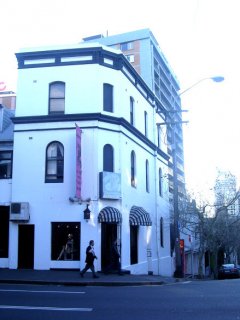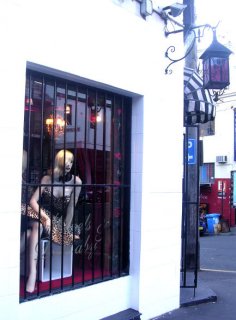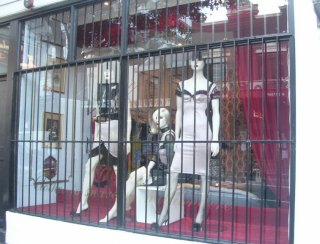softgrey
flaunt the imperfection
- Joined
- Jan 28, 2004
- Messages
- 52,893
- Reaction score
- 319
May 28th, 2008 - Perth





What started as a way of making quick clothes for friends in bands became a life-long business venture for Melanie Greensmith, the designer of Wheels & Dollbaby. Named after the undercover monikers of Agent 99 and Maxwell Smart in Get Smart, the label, celebrating 25 years in the rag trade, is the epitome of rock and roll fashion. Now stocked worldwide and having had concessions within the walls of high-end department stores Harvey Nichols, Harrods, Selfridges and Fred Segal, Melanie has gone from making clothes for unsigned bands to dressing Debbie Harry. We talked to her from her country estate in Australia.
JC Report: The Wheels & Dollbaby tagline, "Clothes to Snare a Millionaire," caused a bit of fuss in America. What happened?
Melanie Greensmith: It's a tongue-in-cheek throwaway comment meaning you will look so hot you could grab yourself a millionaire by accident in one of our garments. While our stuff is sexy, it also has a lot of innocence and is beautifully cut and well-designed. So we had this party at the Chateau Marmont to launch a collection and all the fashion people thought we were some new sex brand. But when they came to the party and saw the garments they got it. When we launched in England at Harvey Nichols, they thought it was hilarious. JCR: You brought Dita Von Teese to Australia before she was really known.
MG: I really didn't realize the fuss that would come from that—it was very exciting.
JCR: You have also had Debbie Harry as the face of your campaign. Is it important to stay on top of who is inspiring to front your campaigns?
MG: Yes, I think it is important that the women I choose in body represent the style I am selling. I like to pick women of certain substance. Not just pop idols. When we got Debbie, it was amazing because she is actually an incredible songwriter and part of modern culture. As we have been around for 25 years as a brand, I like to be adjoined to things and people that are credible. They are not just here for five minutes.
JCR: You started selling belt buckles on Kings Road in England. What made you get into the rag trade?
MG: I just loved clothes. Living in England, I was 19 and mixing with musicians, fashion people. England was all about Vivienne Westwood, Boy London, The Clash, Adam and the Ants and The Pretenders. It was an inspiring time. I wanted all these clothes and couldn't afford them. So I started making my own and dressing boys in bands. They would say "I want a ¾-sleeved striped shirt Mel." There was a Triumph belt craze at the time. Even Karl Lagerfeld did one in gold. I went and researched where to buy them, and I started selling them up and down Kings Road. From there, I met the people I needed to know to get into the business and it started from there. I didn't want to be washing dishes at Dickens & Jones for much longer.
JCR: When you lived in Sydney, you hung out with rock stars that were getting into trouble with the law. Instead, you were paying off your first mortgage and working on your label. What was it that drew you to rock if it wasn't about being bad?
MG: Well, I didn't want to be bad. I liked interesting, charismatic men. Unfortunately, most of them are trouble. At a certain stage when you are younger you work that out. And say to yourself "well, this has all been a lot of fun, but this is going to get tragic pretty soon." I was never a big drinker or any of that—I liked the scene of it.
JCR: What music are you listening to at the moment?
MG: The Beatles, Tom Petty, The Libertines and vintage Madonna (laughs), because she is an inspiration to us all.
JCR: After being stocked everywhere from Fred Segal to Harvey Nichols, you are now a national fashion icon—how does that feel?
MG: Am I? I guess it feels good because when I was younger it was a lot straighter than it is now. You sort of had to fit in a box to be successful. I didn't have a big education but I was creative and strong-willed. To have come through and have done it how I wanted and be recognized for doing something that makes people happy is great. It shows other girls you don't have to do it a certain way. There are many paths to success.
This interview was conducted by Retna Wooller.
jcreport.com





What started as a way of making quick clothes for friends in bands became a life-long business venture for Melanie Greensmith, the designer of Wheels & Dollbaby. Named after the undercover monikers of Agent 99 and Maxwell Smart in Get Smart, the label, celebrating 25 years in the rag trade, is the epitome of rock and roll fashion. Now stocked worldwide and having had concessions within the walls of high-end department stores Harvey Nichols, Harrods, Selfridges and Fred Segal, Melanie has gone from making clothes for unsigned bands to dressing Debbie Harry. We talked to her from her country estate in Australia.
JC Report: The Wheels & Dollbaby tagline, "Clothes to Snare a Millionaire," caused a bit of fuss in America. What happened?
Melanie Greensmith: It's a tongue-in-cheek throwaway comment meaning you will look so hot you could grab yourself a millionaire by accident in one of our garments. While our stuff is sexy, it also has a lot of innocence and is beautifully cut and well-designed. So we had this party at the Chateau Marmont to launch a collection and all the fashion people thought we were some new sex brand. But when they came to the party and saw the garments they got it. When we launched in England at Harvey Nichols, they thought it was hilarious. JCR: You brought Dita Von Teese to Australia before she was really known.
MG: I really didn't realize the fuss that would come from that—it was very exciting.
JCR: You have also had Debbie Harry as the face of your campaign. Is it important to stay on top of who is inspiring to front your campaigns?
MG: Yes, I think it is important that the women I choose in body represent the style I am selling. I like to pick women of certain substance. Not just pop idols. When we got Debbie, it was amazing because she is actually an incredible songwriter and part of modern culture. As we have been around for 25 years as a brand, I like to be adjoined to things and people that are credible. They are not just here for five minutes.
JCR: You started selling belt buckles on Kings Road in England. What made you get into the rag trade?
MG: I just loved clothes. Living in England, I was 19 and mixing with musicians, fashion people. England was all about Vivienne Westwood, Boy London, The Clash, Adam and the Ants and The Pretenders. It was an inspiring time. I wanted all these clothes and couldn't afford them. So I started making my own and dressing boys in bands. They would say "I want a ¾-sleeved striped shirt Mel." There was a Triumph belt craze at the time. Even Karl Lagerfeld did one in gold. I went and researched where to buy them, and I started selling them up and down Kings Road. From there, I met the people I needed to know to get into the business and it started from there. I didn't want to be washing dishes at Dickens & Jones for much longer.
JCR: When you lived in Sydney, you hung out with rock stars that were getting into trouble with the law. Instead, you were paying off your first mortgage and working on your label. What was it that drew you to rock if it wasn't about being bad?
MG: Well, I didn't want to be bad. I liked interesting, charismatic men. Unfortunately, most of them are trouble. At a certain stage when you are younger you work that out. And say to yourself "well, this has all been a lot of fun, but this is going to get tragic pretty soon." I was never a big drinker or any of that—I liked the scene of it.
JCR: What music are you listening to at the moment?
MG: The Beatles, Tom Petty, The Libertines and vintage Madonna (laughs), because she is an inspiration to us all.
JCR: After being stocked everywhere from Fred Segal to Harvey Nichols, you are now a national fashion icon—how does that feel?
MG: Am I? I guess it feels good because when I was younger it was a lot straighter than it is now. You sort of had to fit in a box to be successful. I didn't have a big education but I was creative and strong-willed. To have come through and have done it how I wanted and be recognized for doing something that makes people happy is great. It shows other girls you don't have to do it a certain way. There are many paths to success.
This interview was conducted by Retna Wooller.
jcreport.com






